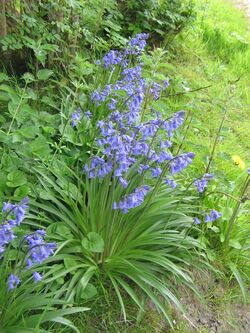Biology:Hyacinthoides × massartiana
| Hyacinthoides × massartiana | |
|---|---|

| |
| Scientific classification | |
| Kingdom: | Plantae |
| Clade: | Tracheophytes |
| Clade: | Angiosperms |
| Clade: | Monocots |
| Order: | Asparagales |
| Family: | Asparagaceae |
| Subfamily: | Scilloideae |
| Genus: | Hyacinthoides |
| Species: | H. × massartiana
|
| Binomial name | |
| Hyacinthoides × massartiana Geerinck
| |
| Synonyms | |
|
"Hyacinthoides × variabilis" P.D.Sell | |
Hyacinthoides × massartiana is a hybrid species produced by crosses between the common bluebell, H. non-scripta and the Spanish bluebell, H. hispanica. H. × massartiana fills a spectrum of variation which connects the two parental species.[1]
Distribution
Hyacinthoides × massartiana has become widespread across Britain and Belgium,[2] both of which have large populations of H. non-scripta. It is often found on the edges of woodland and roadsides, particularly in urban areas, suggesting that it has spread from gardens planted with H. hispanica.[3] There is great concern over the effect that the hybrid may have on native H. non-scripta populations, diluting the characteristics of the native species and out-competing it due to H. hispanica's robust fertility and the effects of climate change.[4]
Taxonomic history
Hybrids between H. non-scripta and H. hispanica were first given a specific name in 1997, when the Belgian botanist D. Geerinck described them as H. × massartiana,[5] honouring the botanist Jean Massart.[6] The type locality is Watermael-Boitsfort, near Brussels, Belgium; the holotype is held in Brussels, with an isotype in Liège.[7] The same taxon had already been given the name "Hyacinthoides × variabilis" by P. D. Sell in 1996 in the Flora of Great Britain and Ireland,[8] but without a valid Latin diagnosis.[6]
References
- ↑ Clive A. Stace (2010). "Hyacinthoides Heist. ex Fabr. (Endymion Dumort.) – bluebells". New Flora of the British Isles (3rd ed.). Cambridge: Cambridge University Press. pp. 920–921. ISBN 978-0-521-70772-5. https://archive.org/details/newflorabritishi00stac.
- ↑ Verloove, Filip (5 March 2018). "Hyacinthoides x massartiana". http://alienplantsbelgium.be/content/hyacinthoides-x-massartiana.
- ↑ "Hyacinthoides non-scripta, H. hispanica & H. x massartiana". 30 August 2010. http://sppaccounts.bsbi.org/content/hyacinthoides-non-scripta-h-hispanica-h-x-massartiana.html.
- ↑ Hyslop, Sally (21 May 2015). "Citizen Science Blog: Native and non-native | Bluebell survey". https://www.nhm.ac.uk/natureplus/community/citizen_science/blog/2015/05/21/native-and-non-native-bluebell-survey.html.
- ↑ D. Geerinck (1997). "Une épithète pour l'hybride Hyacinthoides hispanica (Mill.) Rothm. × H. non-scripta (L.) Chouard ex Rothm.: H. × massartiana Geerinck (Liliaceae)". Belgian Journal of Botany 129 (1): 83–85.
- ↑ 6.0 6.1 Eric J. Clement (2000). "The hybrid bluebell, H. × massartiana". BSBI News (Botanical Society of the British Isles) 84: 24. http://www.watsonia.org.uk/BSBINews84.pdf.[yes|permanent dead link|dead link}}]
- ↑ Michael Grundmann; Fred J. Rumsey; Stephen W. Ansell; Stephen J. Russell; Sarah C. Darwin; Johannes C. Vogel; Mark Spencer; Jane Squirrell et al. (2010). "Phylogeny and taxonomy of the bluebell genus Hyacinthoides, Asparagaceae [Hyacinthaceae]". Taxon 59 (1): 68–82. doi:10.1002/tax.591008.
- ↑ P. D. Sell; G. Murrell (1996). "Liliaceae". Butomaceae–Orchidaceae. Flora of Great Britain and Ireland. 5. Cambridge: Cambridge University Press. pp. 251–294. ISBN 978-0-521-55339-1.
External links
- Hannah Briggs (April 11, 2012). "Bluebells: the survival battle of Britain's native bluebells". BBC News. Archived from the original on April 12, 2012. https://web.archive.org/web/20120412184513/http://www.bbc.co.uk/news/magazine-17597489.
Wikidata ☰ Q15296397 entry
 |

